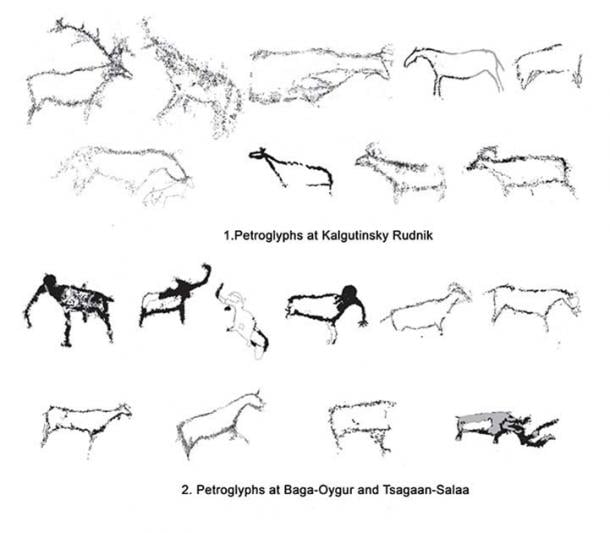
Paleolithic rock art found in Siberia and Mongolia is some 7,000 years older than previously thought, with ancient artists using the same artistic style in both locations.
Scientists have closely examined and compared intriguing rock drawings on the Ukok Plateau in Russia’s Altai Republic and Baga-Oygur, and Tsagaan-Salaa in northwestern Mongolia. The petroglyphs are now in different countries, but in fact they are only about 20 kilometers (12 miles) apart.
New Discoveries Resolve Unanswered Questions
The drawings were mostly found in the 1990s and early 2000s but many questions at the time remained unanswered. In particular, there was a dispute between experts as to whether the drawings showed extinct woolly mammoths that once roamed these parts – or fantastical creatures with trunks.

The Paleolithic rock art of two mammoths discovered at Baga-Oygur II in early 2000s. (Dmitry Cheremisin et al. / Siberian Times)
The new study by Russian and French researchers found new petroglyphs, which have helped the answer this conundrum. For example, at Baga-Oygur II the image of a long-gone woolly rhino was found. However, most of the image is lost due to a rock slicing, but the animal is quite recognizable with an elongated squat torso, short powerful legs, a characteristic tail, and an elongated muzzle with exaggeratedly enlarged two horns.

The team of archaeologists inspecting the Paleolithic rock art at Kalgutinsky Rudnik, Russia. (Hugues Plisson & Lidia Zotkina / Siberian Times)
This discovery was useful because animals, like mammoths became extinct around 15,000 years ago in this region, making the drawings the work of Paleolithic artists. Another new image at Baga-Oygur III evidently shows a mammoth calf.

The Paleolithic rock art image of the mammoth calf discovered at Baga-Oygur III in 2017. (Dmitry Cheremisin et al. / Siberian Times)
The scientists concluded that the artists worked with stone implements, and not metal. They also noted a ‘desert varnish’ on the stones – a dark crust which forms on the stones in dry conditions, suggesting a greater age than earlier assumptions of between 8,000 and 10,000 years old.
Paleolithic Rock Art Shows Similarities Across Regions
Stylistic similarities between the Mongolian and Siberian petroglyphs, further indicated the Ukok drawings to be woolly mammoths. They made their petroglyphs in the so-called Kalgutinsky style.

Comparison of the Paleolithic rock art at the Kalgutinsky Rudnik site to the petroglyphs at Baga-Oygur and Tsagaan-Salaa sites. (Vyacheslav Molodin et al. / Siberian Times)
The experts concluded: “we attribute the petroglyphs to the Final Upper Paleolithic period, because the examples with typical features of this style depict the Pleistocene fauna (mammoths, rhinoceros). These stylistic features find their parallels among the typical examples of the Upper Paleolithic rock art of Europe.”
Russian scientist Vyacheslav Molodin added: “this is a new touch to what we know about the unexplainable activities of prehistoric people in Central Asia. Science already knows about the Paleolithic era art in this region, which includes the famous series of sculptures from the Mal’ta archaeological site in the Irkutsk region of Siberia, whose ages are dated from 23,000 to 19,000 years ago, and also several examples from Angara. Therefore, the assumption that the Pleistocene inhabitants undertook rock art on open surfaces fits into this context.”

Joint Russian-French scientific team studying the Paleolithic rock art at Kalgutinsky Rudnik. (Hugues Plisson & Lidia Zotkina / Siberian Times)
The research was undertaken by Vyacheslav Molodin, Dmitry Cheremisin and Dr. Lidia Zotkina from the Institute of Archaeology and Ethnography, Novosibirsk, part of the Siberian Branch of the Russian Academy of Sciences, Jean-Michele Geneste (University of Bordeaux) and Catherine Cretin (National Museum of Prehistory, France).
Their article ‘The Kalgutinsky Style in the Rock Art of Central Asia’ was published in late 2019, in the magazine Archaeology, Ethnology & Anthropology of Eurasia (issued by Institute of Archaeology and Ethnography SB RAS).
Top image: The Paleolithic rock art of the mammoth discovered at Baga-Oygur III in early 2000s. Source: Institute of Archaeology and Ethnography SB RAS / Siberian Times
The article, originally titled ‘Alfresco art gallery ‘shows woolly mammoths and rhinos depicted by our ancestors 15,000 years ago’ first appeared on The Siberian Times dated 24/04/2020 and has been republished with permission.